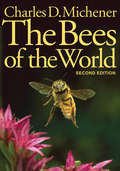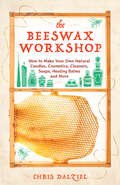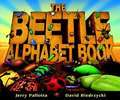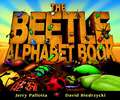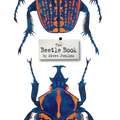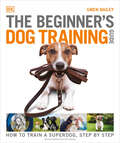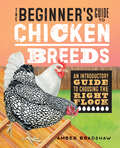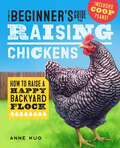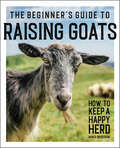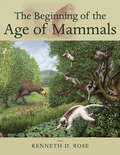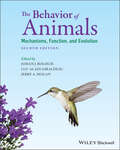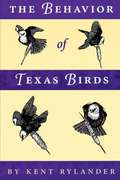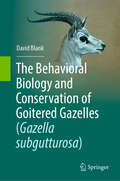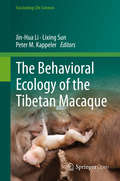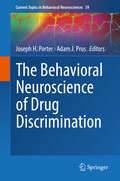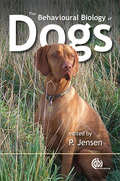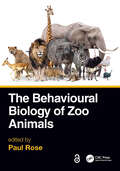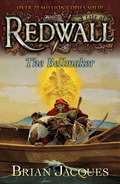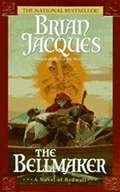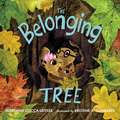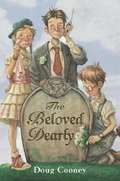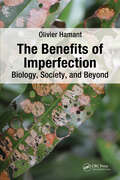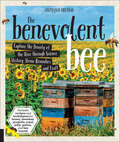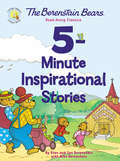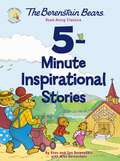- Table View
- List View
The Bees of the World
by Charles D. MichenerIn this extensive update of his definitive reference, Charles D. Michener reveals a diverse fauna that numbers more than 17,000 species and ranges from the common honeybee to rare bees that feed on the pollen of a single type of plant. With many new facts, reclassifications, and revisions, the second edition of The Bees of the World provides the most comprehensive treatment of the 1,200 genera and subgenera of the Apiformes. Included are hundreds of updated citations to work published since the appearance of the first edition and a new set of plates of fossil bees.The book begins with extensive introductory sections that include bee evolution, classification of the various bee families, the coevolution of bees and flowering plants, nesting behavior, differences between solitary and social bees, and the anatomy of these amazing insects. Drawing on modern studies and evidence from the fossil record, Michener reveals what the ancestral bee—the protobee—might have looked like. He also cites the major literature on bee biology and describes the need for further research on the systematics and natural history of bees, including their importance as pollinators of crops and natural vegetation. The greater part of the work consists of an unprecedented treatment of bee systematics, with keys for identification to the subgenus level. For each genus and subgenus, Michener includes a brief natural history describing geographical range, number of species, and noteworthy information pertaining to nesting or floral biology.The book is beautifully illustrated with more than 500 drawings and photographs that depict behavior, detailed morphology, and ecology. Accented with color plates of select bees, The Bees of the World will continue to be the world's best reference on these diverse insects.
The Beeswax Workshop: How to Make Your Own Natural Candles, Cosmetics, Cleaners, Soaps, Healing Balms and More
by Christine J. DalzielOver 100 recipes to transform this miracle ingredient into environmentally friendly household cleaner, personal care products, candles, and more.Making all kinds of amazing, all-natural stuff out of beeswax is easy and fun. Packed with over 100 step-by-step recipes, The Beeswax Workshop shows you how to make beautiful gifts, household cleaners, beauty supplies and so, so much more. Projects in this book include:HOME• Mason Jar Candle• English Furniture PolishHEALTH• Bug-Be-Gone Insect Repellent• Chamomile Sunburn SalveBEAUTY• Everyday Body Butter• Rose Lip GlossGARDEN• Waterproof Shade Hat• Nontoxic Wood SealantWhether you use beeswax from your backyard hive or purchase a supply, this book offers tips, tricks and techniques for getting the most out of this miracle ingredient.
The Beetle Alphabet Book
by Jerry PallottaUses letters of the alphabet to introduce various kinds of beetles.
The Beetle Alphabet Book (Jerry Pallotta's Alphabet Books)
by Jerry PallottaLearn your beetles from A to Z as they crawl their way through the alphabet. Get to know the most diverse species on earth in this entertaining and informative nature ABC book. From the Dung Beetle to the Kalahari Beetle to the Zinc Metallic Beetles, the book is both fact-filled and fun for young readers. Full of Jerry Pallotta's signature humor and brought to life with bold artwork by award-winning illustrator, David Biedrzycki. A great introduction for the insect-enthused and lovers of all things that creep and crawl.
The Beetle Book
by Steve JenkinsBeetles squeak and beetles glow. Beetles stink, beetles sprint, beetles walk on water. With legs, antennae, horns, beautiful shells, knobs, and other oddities--what's not to like about beetles? The beetle world is vast: one out of every four living things on earth is a beetle. There are over 350,000 different species named so far and scientists suspect there may be as many as a million. From the goliath beetle that weighs one fourth of a pound to the nine inch long titan beetle, award-winning author-illustrator Steve Jenkins presents a fascinating array of these intriguing insects and the many amazing adaptations they have made to survive.
The Beginner's Dog Training Guide: How to Train a Superdog, Step by Step
by Gwen BaileyUnleash your dog's potential and build a rewarding relationship that will last a lifetime!From walking on a loose lead to carrying the shopping, The Beginner's Dog Training Guide has everything you need to know to train your dog and ensure you have a happy canine companion. Choose the right dog breed for you and then keep your dog healthy by understanding their exercise, diet, and grooming needs. Follow clear, step-by-step explanations and illustrations to learn every aspect of owning and training a dog, from basic obedience to advanced tricks.Expert advice accompanied by over 800 clear photographs provide a user-friendly visual guide to training your dog, by showing you exactly what to do. Filled with tips and tricks, this book will help you become the owner of a well-behaved, healthy, and happy dog!This dog training book promises:- An easy-to-follow approach to understanding dog behavior and dog training based on the latest research into canine intelligence- Offers expert guidance on selecting the right dog for you, with a catalog of the most popular breeds- Features behavioral analysis to help you understand what your dog is thinking- More than 800 photographs provide clear visual guidance so you know exactly what to do to succeed with your dog A must-have volume for families training their new pet, for first-time dog owners and experienced owners alike as well as those interested in training theory and dog psychology.
The Beginner's Guide to Chicken Breeds: An Introductory Guide to Choosing the Right Flock
by Amber BradshawGrow your flock with practical, breed-specific advice for beginners Deciding to raise chickens is one thing, but figuring out which breeds will suit your needs is another—especially with hundreds of different types! Whether you're raising chickens for eggs, meat, companionship, or show, The Beginner's Guide to Chicken Breeds has all the information you need to get started. This easy-to-use reference book helps you assess your needs and guides you in making the best decisions for beginning or expanding your flock. Get to know top-tier pure breeds and hybrids, optimal egg-layers and broilers, ideal chicken breeds for beginners, and more. For every category of chicken, you'll find an ultimate breed list that highlights the unique qualities and strengths of each, and breaks down the key considerations of owning them. The Beginner's Guide to Chicken Breeds includes: Beginner-friendly guidance—Get started with expert insights, answers to commonly asked questions, lists of pros and cons, and a best-fit questionnaire to help you narrow down the right chicken breeds for you. Cost estimates—Plan for all the expenses associated with raising a backyard flock, including the chicken coop, food, veterinary bills, cleaning products, and other supplies. Chicken characteristics—Explore key breed-specific traits, including average weight and appearance, harvest age, egg production and color, temperament, climate hardiness, and more. Discover everything you need to know to pick the perfect chicken breeds for your lifestyle with this essential beginner's guide.
The Beginner's Guide to Raising Chickens: How to Raise a Happy Backyard Flock
by Anne KuoThe beginner's complete guide raising happy backyard chickens—your new summer activity!The Beginner's Guide to Raising Chickens makes it easy to start keeping these surprisingly smart birds right in your own backyard. From constructing coops to rearing chicks, you'll learn everything you need to know to make sure your chickens stay happy and healthy all year round.Which breed of chicken is right for you? What's the best bedding material? What sort of feed should you use? Expert chicken keeper Anne Kuo answers these questions—and many others—in this fun and friendly reference book that will get you excited to raise your new feathered friends.This book on raising chickens guides you through:Getting from the chicken to the egg—Find out how to raise chicks, keep your birds safe from predators, introduce new birds to the flock, and more.Creating a custom coop—Build the perfect home for raising chickens with detailed backyard coop construction guides.Expert care advice—Learn how to identify different behaviors in your chicken, help solve egg shortages, and navigate a range of potential surprises with confidence.Start the perfect summer hobby when you grab the The Beginner's Guide to Raising Chickens.
The Beginner’s Guide to Raising Goats: How to Keep A Happy Herd
by Amber BradshawMake bucks (and plenty of kids) by raising goats.Whether you're looking to be self-sufficient, or you want to make some money on the side, goats are perfect for milk and cheese, meat, and fiber. Taking care of goats could be your newest summer activity. The Beginner's Guide to Raising Goats can help you get the most out of these hearty herd animals with step-by-step instructions and easy-to-follow tips for newcomers.From Angoras to Nigerian Dwarfs, this beginner's guide to raising goats will break down the dos and don'ts to starting your herd. Learn how to pick the right kind of goat for your homestead's needs, build fences and shelters, feed and breed them, and more. Raising goats can be a wonderful adventure in family fun this summer, that not only teaches valuable life skills to the younger ones but also delivers a valuable resource to your table. There's even a recipe section in the back that shows you how to use their fresh meat and milk to make tasty home-cooked meals like Goat Chili and Goat Mac N' Cheese.The Beginner's Guide to Raising Goats features:Goats 101—Discover an in-depth overview that gives you everything you need to know about raising goats.Share your bounty—Explore practical tips that show you how to start a side business selling goat milk, cheese, and meat.Dollars & sense—Get a cost estimate and approximate timelines for raising animals, making dairy products, and selling them for profit.Learn how goats can help create a more sustainable life with this essential beginner's guide.
The Beginning of the Age of Mammals
by Kenneth D. RoseIn the tradition of G. G. Simpson's classic work, Kenneth D. Rose's The Beginning of the Age of Mammals analyzes the events that occurred directly before and after the mysterious K-T boundary which so quickly thrust mammals from obscurity to planetary dominance. Rose surveys the evolution of mammals, beginning with their origin from cynodont therapsids in the Mesozoic, contemporary with dinosaurs, through the early Cenozoic, with emphasis on the Paleocene and Eocene adaptive radiations of therian mammals. Focusing on the fossil record, he presents the anatomical evidence used to interpret behavior and phylogenetic relationships. The life's work of one of the most knowledgeable researchers in the field, this richly illustrated, magisterial book combines sound scientific principles and meticulous research and belongs on the shelf of every paleontologist and mammalogist.
The Behavior of Animals: Mechanisms, Function, and Evolution
by Luc-Alain Giraldeau Jerry A. Hogan Johan J. BolhuisThe Behavior of Animals An updated view of animal behavior studies, featuring global experts The Behavior of Animals, Second Edition provides a broad overview of the current state of animal behavior studies with contributions from international experts. This edition includes new chapters on hormones and behavior, individuality, and human evolution. All chapters have been thoroughly revised and updated, and are supported by color illustrations, informative callouts, and accessible presentation of technical information. Provides an introduction to the study of animal behavior Looks at an extensive scope of topics- from perception, motivation and emotion, biological rhythms, and animal learning to animal cognition, communication, mate choice, and individuality. Explores the evolution of animal behavior including a critical evaluation of the assumption that human beings can be studied as if they were any other animal species. Students will benefit from an updated textbook in which a variety of contributors provide their expertise and global perspective in specialized areas
The Behavior of Texas Birds
by Kent RylanderWhether it's the sudden, plunging dives of Brown Pelicans, the singing and aerial displays of Northern Mockingbirds, or the communal nesting of Purple Martins, innate and learned behaviours are some of the most fascinating things to observe in Texas birds. Even casual birdwatchers eventually ask, ""why do they do that?"" while serious birders and ornithologists seek to understand all the behaviours involved in feeding, flying, mating, and rearing young. But until now, it has been hard to find this information in one handy source. In this comprehensive, yet easy-to-use book, Kent Rylander distils data from many sources to provide an authoritative guide to the behaviour of Texas birds. He begins by explaining the principles of animal behaviour and illustrating how they can be applied to interpreting bird behaviours in the field. The majority of the book is devoted to accounts of more than 400 species of birds that are most likely to be encountered by Texas birdwatchers. Each account describes such behaviours as feeding, courtship, parenting, and other behaviours that are significant for that species.
The Behavioral Biology and Conservation of Goitered Gazelles (Gazella subgutturosa)
by David BlankThis comprehensive and lavishly illustrated book summarizes all known information on the Goitered Gazelle (Gazella subgutturosa), one of the world's most endangered antelopes. It includes information on topics such as feeding ecology, behavior, vocalizations, parasites and diseases, and conservation. This research monograph will be of interest to professional researchers of ungulates, university staff, students, and naturalists.
The Behavioral Ecology of the Tibetan Macaque (Fascinating Life Sciences)
by Peter M. Kappeler Jin-Hua Li Lixing SunThis open access book summarizes the multi-disciplinary results of one of China’s main primatological research projects on the endemic Tibetan macaque (Macaca thibetana), which had continued for over 30 years, but which had never been reported on systematically. Dedicated to this exceptional Old World monkey, this book makes the work of Chinese primatologists on the social behavior, cooperation, culture, cognition, group dynamics, and emerging technologies in primate research accessible to the international scientific community.One of the most impressive Asian monkeys, and the largest member of its genus, the Tibetan macaque deserves to be better known. This volume goes a long way towards bringing this species into the spotlight with many excellent behavioral analyses from the field. - Frans de Waal, Professor of Psychology, Emory University, USA.Macaques matter. To understand primate patterns and trends, and to gain important insight into humanity, we need to augment and expand our engagement with the most successful and widespread primate genus aside from Homo. This volume focuses on the Tibetan macaque, a fascinating species with much to tell us about social behavior, physiology, complexity and the macaque knack for interfacing with humans. This book is doubly important for primatology in that beyond containing core information on this macaque species, it also reflects an effective integrated collaboration between Chinese scholars and a range of international colleagues—exactly the type of collaborative engagement primatology needs. This volume is a critical contribution to a global primatology. - Agustín Fuentes, Professor of Anthropology, University of Notre Dame, USA. I have many fond memories of my association with Mt. Huangshan research beginning in 1983, when together with Professor Qishan Wang we established this site. It is such a beautiful place and I miss it. It is gratifying to see how far research has progressed since we began work there, becoming more internationalized and very much a collaborative endeavor under the long-term direction of Professor Jin-Hua Li and colleagues. This book highlights the increased interest in this species, representing a variety of disciplines ranging from macro aspects of behavior, cognition and sociality, to micro aspects of microbes, parasites and disease, authored by a group of renowned Chinese and international primatologists. I applaud their efforts and expect more interesting work to come from this site in the years ahead. - Kazuo Wada, Professor Emeritus, Kyoto University, Japan.
The Behavioral Neuroscience of Drug Discrimination (Current Topics in Behavioral Neurosciences #39)
by Joseph H. Porter Adam J. PrusThe goal for this volume is to provide an up-to-date review of the discriminative stimulus properties of major psychoactive drug classes with an emphasis on how this paradigm enhances our understanding of these drugs and how these findings translate from animals to humans. The drug discrimination paradigm applies to both drugs of abuse and drugs for treating mental illnesses, and research from these studies has provided immense translational value for learning about the mechanisms responsible for drug effects in humans.
The Behavioural Biology of Dogs
by Per JensenAs humans oldest domesticated animals, dogs serve as an excellent model for studying how mammal behavior and cognition have evolved. So states Jensen (biology, Linköping U., Sweden) in introducing 14 chapters intended for students in animal behavior or veterinary medicine. International researchers present up-to-date information on aspects of Caninae species diversity and behavior in evolutionary and social ecological contexts. General readers may find the sections treating dog personality, behavioral problems and their link to disease of interest. Lightly-illustrated chapters include references and further suggested reading.
The Behavioural Biology of Zoo Animals
by Paul Rose"Zoo animals" as a population are a diverse array of species from all around the globe. When managed in captivity, it is important that key aspects of natural ecology are factored into animal care, as well as considerations relating to welfare, life history and behavioural needs. The Behavioural Biology of Zoo Animals is the first book on captive animal behaviour and how this applies to welfare. The book enables all aspects of zoo husbandry and management (nutrition, enclosure design, handling and training, enrichment, population management) to be based on a sound knowledge of the species, its evolutionary history and its natural history. Chapters from expert authors cover a vast range of taxa, from primates and elephants to marine mammals and freshwater fish, to reptiles, birds and invertebrates. A final part looks to the future, considering animal health and wellbeing, the visitor experience and future visions for zoos and aquariums. For on-the-ground practitioners as well as students of zoo biology, animal science and welfare, this book provides an explanation of key areas of behavioural biology that are important to fulfilling the aims of the modern zoo (conservation, education, research and recreation). It explains how evidence from the wild can be implemented into captive care to support the wider aims of the zoo, shedding light on the evidence-based approaches applied to zoo biology and animal management. Chapter 3 is available to download Open Access on the www.taylorfrancis.com website.Aa Companion Website with additional resources is freely available for all at www.bbzabook.wordpress.com and you can follow the book on Instagram at @bbza_book.
The Bellmaker
by Brian JacquesIt has been four seasons since Mariel, the warrior-mouse daughter of Joseph the Bellmaker, and her companion, Dandin, set off from Redwall to fight evil in Mossflower. Nothing has been heard of them since. Then one night, in a dream, the legendary Martin the Warrior comes to the Bellmaker with a mysterious message. Clearly, Mariel and Dandin are in grave danger. Joseph and four Redwallers set off at once to aid them. As they push over land and sea, they cannot know the terrible threats they face. Will the Bellmaker and his companions arrive in time to help Mariel and Dandin?
The Bellmaker (Redwall, Book #7)
by Brian JacquesMore than four seasons have passed since Mariel the Warriormouse and the rogue mouse, Dandin, set off from Redwall in search of adventure, and Joseph the Bellmaker is worried. Where is his beloved daughter? Joseph's answer comes to him in a dream, and soon he's off, accompanied by the intrepid Finnbarr Galedeep and the brave crew of the good ship, Pearl Queen, to save a kingdom and rescue Mariel. But what's behind the riddle in the dream? Can Joseph guess its meaning and find his daughter? Can this be the end of Mariel the Warriormouse? The momentous questions of this seventh epic in the Redwall series will hold a new audience of readers in its magical spell and captivate dedicated Redwall followers as well.
The Belonging Tree
by Maryann Cocca-LefflerThe Belonging Tree is a thoughtful picture book about respect, inclusion, and acceptance in a woodland community of animals from writer Maryann Cocca-Leffler and illustrator Kristine A. Lombardi.Life was ordinary in the big oak tree on Forest Lane. Squirrels lived in every part of the tree, and the Gray squirrel family inhabited the knot in the middle. But the neighborhood starts to change as the big oak tree welcomes families of chipmunks, beavers, and birds. And with each new arrival, the Grays become increasingly unhappy. Can’t everything remain just as it was?It will take an unexpected moment of heroism from a thoughtful inhabitant to finally open hearts and bind together this diverse animal community.Christy Ottaviano Books
The Beloved Dearly
by Doug CooneyErnie is a twelve-year-old tycoon, always on the lookout for a fast buck. This time he stumbles onto a money-making bonanza: pet funerals. He hires Dusty to decorate the burial boxes and Tony to dig the holes, but his prize find is Swimming Pool, a tomboy who delivers a crying jag not to be missed. Business goes through the roof -- until Ernie loses Swimming Pool over a raise and the whole venture unravels. Here is a rollicking, fun-spirited novel about friendship, loss, business -- and how we learn to express our feelings. As a stage play,The Beloved Dearly was toured by the Lincoln Center Institute in a production directed by Elizabeth Swados. The play has also been produced at TADA!, where it was awarded the First Look Prize; South Coast Repertory; Florida Stage; and Riverside Children's Theatre; and it has been published by Dramatic Publishing.
The Benefits of Imperfection: Biology, Society, and Beyond
by Olivier HamantThe cult of performance leads our society to emphasise the values of success and continuous optimisation in all areas. Slowness, redundancy and randomness are therefore negatively perceived. Olivier Hamant, in his book, reclaims them by his knowledge of biological processes.What can we learn from life sciences? While some biological mechanisms certainly boast formidable efficiency, recent advances instead highlight the fundamental role of errors, incoherence or slowness in the robustness of living organisms. Should life be considered suboptimal? To what extent could suboptimality become a counter-model to the credo of performance and control in the Anthropocene?In the face of pessimistic observations and environmental alerts, the author outlines solutions for a future that is viable and reconciled with nature.Key Features: Solidly documents with a grounding in scientific facts focusing on solutions Explores a pragmatic way towards robustness, moving the debate beyond performance, technolatry or degrowth Responds to eco-anxiety by providing an engaging and viable way forward
The Benevolent Bee: Capture the Bounty of the Hive through Science, History, Home Remedies, and Craft
by Stephanie BruneauA beekeeper and herbalist shares how you can use six products of the beehive: honey, pollen, propolis, royal jelly, beeswax, and bee venom. Not all new beekeepers realize that a honeybee hive produces a lot more than just honey. While your hard-working ladies will produce delicious honey, the hive as a whole also produces pollen, propolis, royal jelly, beeswax, and bee venom; all very useful things for humans, if we know how to use them.The Benevolent Bee describes how and why the bees make these products, how they&’ve been used by humans throughout the ages, and how beekeepers can harvest the products. It also presents simple do-it yourself recipes for using the products in health and wellness, body care, nutrition, and craft. You'll learn how to make salves for burns and a cough syrup from raw honey; how to make a tincture, an infused oil, and a mouthwash from propolis, the anti-bacterial &“bee glue&” that lines the inside of the hive; and much more. Get crafting now, it&’s all already in your hive!
The Berenstain Bears 5-Minute Inspirational Stories
by Stan Berenstain w/ Mike Berenstain<P>The Berenstain Bears 5-Minute Read-Along Stories is the perfect companion for young readers at bedtime or anytime.<P> With classic stories from the Berenstain Bears Living Lights series, join the Bear family and all their friends in Bear Country as they learn how to be good friends, how to play fairly, where to find courage, and much more.<P> This oversize padded storybook is sure to become a lap time favorite for Berenstain fans, both young and old, as they read these stories in 5 minutes.
The Berenstain Bears 5-Minute Inspirational Stories: Read-Along Classics (Berenstain Bears/Living Lights: A Faith Story)
by Stan Berenstain Jan Berenstain Mike BerenstainCalling all Berenstain Bears fans! Young readers will enjoy this collection of 12 stories in this addition to the Living Lights™ series of Berenstain Bears books. Children will learn how to be good friends, how to play fairly, where to find courage, and much more.The Berenstain Bears 5-Minute Inspirational Stories—part of the popular Zonderkidz Living Lights series of books—is perfect for:Early readers ages 4-8Reading out loud during story time or bedtimeBirthday gifts, Easter, holiday gift giving, or as a new addition to your e-libraryThis trusted storybook collection teaches children:How to build courage, create peace, recite prayers, and avoid gossipThe importance of loving thy neighbor, humility, and how to honor GodThe Berenstain Bears 5-Minute Inspirational Stories is an addition to the Living Lights™ series that:Features the hand-drawn artwork of the Berenstain familyContinues in the much-loved footsteps of Stan and Jan Berenstain in this Berenstain Bears series of booksIs part of one of the bestselling children&’s book series ever created, with more than 250 books published and nearly 300 million copies sold to date
